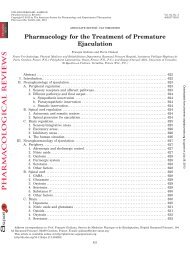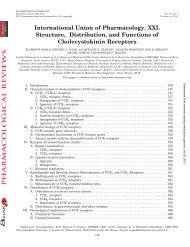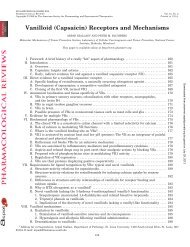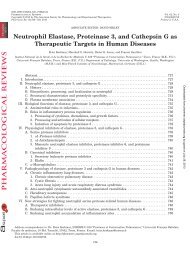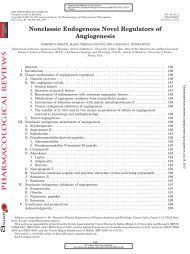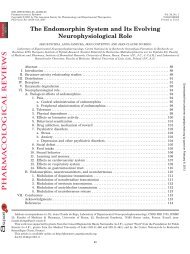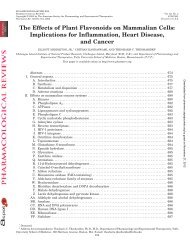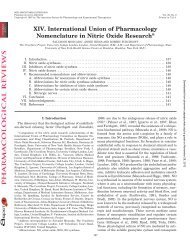Opioids, Reward and Addiction: An Encounter of Biology ...
Opioids, Reward and Addiction: An Encounter of Biology ...
Opioids, Reward and Addiction: An Encounter of Biology ...
You also want an ePaper? Increase the reach of your titles
YUMPU automatically turns print PDFs into web optimized ePapers that Google loves.
392 VAN REE ET AL.<br />
among alcoholics treated with naltrexone or placebo. Am J Psychiatry 153:281–<br />
283.<br />
Oei TP (1983) Effects <strong>of</strong> body weight reduction <strong>and</strong> food-deprivation on cocaine<br />
self-administration. Pharmacol Biochem Behav 19:453–455.<br />
Oei TP, Singer G <strong>and</strong> Jefferys D (1980) The interaction <strong>of</strong> a fixed time food delivery<br />
schedule <strong>and</strong> body weight on self-administration <strong>of</strong> narcotic analgesics. Psychopharmacology<br />
67:171–176.<br />
Olds J, Allan WS <strong>and</strong> Briese E (1971) Differentiation <strong>of</strong> hypothalamic drive <strong>and</strong><br />
reward centers. Am J Physiol 221:368–375.<br />
Olds ME (1979) Hypothalamic substrate for the positive reinforcing properties <strong>of</strong><br />
morphine in the rat. Brain Res 168:351–360.<br />
Olds ME (1982) Reinforcing effects <strong>of</strong> morphine in the nucleus accumbens. Brain Res<br />
237:429–440.<br />
Olds ME <strong>and</strong> Milner P (1954) Positive reinforcement produced by electrical stimulation<br />
<strong>of</strong> the septal area <strong>and</strong> other regions <strong>of</strong> rat brain. J Comp Physiol Psychol<br />
47:419–427.<br />
Olds ME <strong>and</strong> Travis RP (1960) Effects <strong>of</strong> chlorpromazine, meprobamate, pentobarbital<br />
<strong>and</strong> morphine on self-stimulation. J Pharmacol Exp Ther 128:397–404.<br />
Olds ME <strong>and</strong> Williams KN (1980) Self-administration <strong>of</strong> D-Ala 2 -Met-enkephalinamide<br />
at hypothalamic self-stimulation sites. Brain Res 194:155–170.<br />
Olmstead MC <strong>and</strong> Franklin KB (1993) Effects <strong>of</strong> pedunculopontine tegmental nucleus<br />
lesions on morphine-induced conditioned place preference <strong>and</strong> analgesia in<br />
the formalin test. Neuroscience 57:411–418.<br />
Olmstead MC <strong>and</strong> Franklin KB (1997a) The development <strong>of</strong> a conditioned place<br />
preference to morphine: Effects <strong>of</strong> lesions <strong>of</strong> various CNS sites. Behav Neurosci<br />
111:1313–1323.<br />
Olmstead MC <strong>and</strong> Franklin KB (1997b) The development <strong>of</strong> a conditioned place<br />
preference to morphine: Effects <strong>of</strong> microinjections into various CNS sites. Behav<br />
Neurosci 111:1324–1334.<br />
Olmstead MC <strong>and</strong> Franklin KBJ (1996) Differential effects <strong>of</strong> ventral striatal lesions<br />
on the conditioned place preference induced by morphine or amphetamine. Neuroscience<br />
71:701–708.<br />
Olmstead MC, Munn EM, Franklin KBJ <strong>and</strong> Wise RA (1998) Effects <strong>of</strong> pedunculopontine<br />
tegmental nucleus lesions on responding for intravenous heroin under<br />
different schedules <strong>of</strong> reinforcement. J Neurosci 18:5035–5044.<br />
Parker LA (1992) Place conditioning in a three- or four-choice apparatus: role <strong>of</strong><br />
stimulus novelty in drug-induced place conditioning. Behav Neurosci 106:294–<br />
306.<br />
Parker LA <strong>and</strong> Joshi A (1998) Naloxone-precipitated morphine withdrawal induced<br />
place aversions: Effect <strong>of</strong> naloxone at 24 hours postmorphine. Pharmacol Biochem<br />
Behav 61:331–333.<br />
Patel VA <strong>and</strong> Pohorecky LA (1989) Acute <strong>and</strong> chronic ethanol treatment on -endorphin<br />
<strong>and</strong> catecholamine levels. Alcohol 6:59–63.<br />
Pavlov IP (1927) Conditioned Reflexes, Oxford University Press, Oxford.<br />
Pert CB <strong>and</strong> Snyder SH (1973) Opiate receptor: Demonstration in nervous tissue.<br />
Science (Wash DC) 179:1011–1014.<br />
Peterson MR <strong>and</strong> Robertson HA (1984) Effect <strong>of</strong> dopaminergic agents on levels <strong>of</strong><br />
dynorphin 1–8 in rat striatum. Prog Neuropsychopharmacol Biol Psychiatry<br />
8:725–728.<br />
Pettit HO, Batsell WR Jr <strong>and</strong> Mueller K (1989) Triazolam attenuates amphetamine<br />
but not morphine conditioned place preferences. Psychopharmacology 98:483–486.<br />
Pettit HO, Ettenberg A, Bloom FE <strong>and</strong> Koob GF (1984) Destruction <strong>of</strong> dopamine in<br />
the nucleus accumbens selectively attenuates cocaine but not heroin selfadministration<br />
in rats. Psychopharmacology 84:167–173.<br />
Phillips AG <strong>and</strong> LePiane FG (1980) Reinforcing effects <strong>of</strong> morphine microinjection<br />
into the ventral tegmental area. Pharmacol Biochem Behav 12:965–968.<br />
Phillips AG <strong>and</strong> LePiane FG (1982) <strong>Reward</strong> produced by microinjection <strong>of</strong> [D-Ala 2 ],<br />
Met 5 -enkephalinamide into the ventral tegmental area. Behav Brain Res 5:225–<br />
229.<br />
Phillips AG, LePiane FG <strong>and</strong> Fibiger HC (1983) Dopaminergic mediation <strong>of</strong> reward<br />
produced by direct injection <strong>of</strong> enkephalin into the ventral tegmental area <strong>of</strong> the<br />
rat. Life Sci 33:2505–2511.<br />
Phillips TJ, Wenger CD <strong>and</strong> Dorow JD (1997) Naltrexone effects on ethanol drinking<br />
acquisition <strong>and</strong> on established ethanol consumption in C57BL/6J mice. Alcohol<br />
Clin Exp Res 21:691–702.<br />
Piazza PV <strong>and</strong> Le Moal ML (1996) Pathophysiological basis <strong>of</strong> vulnerability to drug<br />
abuse: Role <strong>of</strong> an interaction between stress, glucocorticoids, <strong>and</strong> dopaminergic<br />
neurons. <strong>An</strong>nu Rev Pharmacol Toxicol 36:359–378.<br />
Pickens R <strong>and</strong> Harris WC (1968) Self-administration <strong>of</strong> d-amphetamine by rats.<br />
Psychopharmacologia 12:158–163.<br />
Pickens R <strong>and</strong> Thompson T (1968) Cocaine-reinforced behavior in rats: effects <strong>of</strong><br />
reinforcement magnitude <strong>and</strong> fixed-ratio size. J Pharmacol Exp Ther 161:122–<br />
129.<br />
Piepponen TP, Kivastik T, Katajamaki J, Zharkovsky A <strong>and</strong> Ahtee L (1997) Involvement<br />
<strong>of</strong> opioid 1-receptors in morphine-induced conditioned place preference in<br />
rats. Pharmacol Biochem Behav 58:275–279.<br />
Pilotto R, Singer G <strong>and</strong> Overstreet D (1984) Self-injection <strong>of</strong> diazepam in naive rats:<br />
effects <strong>of</strong> dose, schedule <strong>and</strong> blockade <strong>of</strong> different receptors. Psychopharmacology<br />
84:174–177.<br />
Pollerberg GE, Costa T, Shearman GT, Herz A <strong>and</strong> Reid LD (1983) Opioid antinociception<br />
<strong>and</strong> positive reinforcement are mediated by different types <strong>of</strong> opioid<br />
receptors. Life Sci 33:1549–1559.<br />
Popik P <strong>and</strong> Danysz W (1997) Inhibition <strong>of</strong> reinforcing effects <strong>of</strong> morphine <strong>and</strong><br />
motivational aspects <strong>of</strong> naloxone-precipitated opioid withdrawal by N-methyl-Daspartate<br />
receptor antagonist, memantine. J Pharmacol Exp Ther 280:854–865.<br />
Popik P, Layer RT <strong>and</strong> Skolnick P (1994) The putative anti-addictive drug ibogaine<br />
is a competitive inhibitor <strong>of</strong> [H- 3 ]MK-801 binding to the NMDA receptor complex.<br />
Psychopharmacology 114:672–674.<br />
Popik P, Layer RT <strong>and</strong> Skolnick P (1995) 100 years <strong>of</strong> ibogaine: Neurochemical <strong>and</strong><br />
pharmacological actions <strong>of</strong> a putative anti-addictive drug. Pharmacol Rev 47:235–<br />
253.<br />
Practice Guideline American Psychiatric Association (1995) Practice guideline for<br />
the treatment <strong>of</strong> patients with substance use disorders: Alcohol, cocaine, opioids.<br />
AmJ Psychiatry 152 (Suppl):1–59.<br />
Preshaw RL, Zenick H <strong>and</strong> Stutz RM (1982) Effects <strong>of</strong> parenteral morphine <strong>and</strong> oral<br />
methadone on self-stimulation in the rat. Pharmacol Biochem Behav 16:81–85.<br />
Preston KL, Bigelow GE <strong>and</strong> Liebson IA (1989) <strong>An</strong>tagonist effects <strong>of</strong> nalbuphine in<br />
opioid-dependent human volunteers. J Pharmacol Exp Ther 248:929–937.<br />
Przewlocka B, Dziedzicka M <strong>and</strong> Lason W (1990) The effects <strong>of</strong> ethanol treatment on<br />
endogenous opioid peptides level <strong>and</strong> analgesia in monoarthritic rats. Pol J Pharmacol<br />
Pharm 42:343–349.<br />
Przewlocki R, Höllt, V, Duka T, Kleber G, Gramsch C, Haarmann, I <strong>and</strong> Herz A<br />
(1979) Long-term morphine treatment decreases endorphin levels in rat brain <strong>and</strong><br />
pituitary. Brain Res 174:357–361.<br />
Pulvirenti L <strong>and</strong> Kastin AJ (1988) Naloxone, but not Tyr-MIF-1, reduces volitional<br />
ethanol drinking in rats: Correlation with degree <strong>of</strong> spontaneous preference.<br />
Pharmacol Biochem Behav 31:129–134.<br />
Rada P, Mark GP, Pothos E <strong>and</strong> Hoebel BG (1991) Systemic morphine simultaneously<br />
decreases extracellular acetylcholine <strong>and</strong> increases dopamine in the nucleus<br />
accumbens <strong>of</strong> freely moving rats. Neuropharmacology 30:1133–1136.<br />
Ramsey NF, Gerrits MAFM <strong>and</strong> Van Ree JM (1999) Naltrexone affects cocaine<br />
self-administration in naive rats through the ventral tegmental area rather than<br />
dopaminergic target regions. Eur Neuropsychopharmacol 9:93–99.<br />
Ramsey NF, Niesink RJ <strong>and</strong> Van Ree JM (1993) Prenatal exposure to morphine<br />
enhances cocaine <strong>and</strong> heroin self-administration in drug-naive rats. Drug Alcohol<br />
Depend 33:41–51.<br />
Ramsey NF <strong>and</strong> Van Ree JM (1990) Chronic pretreatment with naltrexone facilitates<br />
acquisition <strong>of</strong> intravenous cocaine self-administration in rats. Eur Neuropsychopharmacol<br />
1:55–61.<br />
Ramsey NF <strong>and</strong> Van Ree JM (1991) Intracerebroventricular naltrexone treatment<br />
attenuates acquisition <strong>of</strong> intravenous cocaine self-administration in rats. Pharmacol<br />
Biochem Behav 40:807–810.<br />
Ramsey NF <strong>and</strong> Van Ree JM (1992) <strong>Reward</strong> <strong>and</strong> abuse <strong>of</strong> opiates. Pharmacol Toxicol<br />
71:81–94.<br />
Ramsey NF <strong>and</strong> Van Ree JM (1993) Emotional but not physical stress enhances<br />
intravenous cocaine self-administration in drug-naive rats. Brain Res 608:216–<br />
222.<br />
Ranaldi R, French E <strong>and</strong> Roberts DCS (1996) Systemic pretreatment with MK-801<br />
(dizocilpine) increases breaking points for self-administration <strong>of</strong> cocaine on a<br />
progressive-ratio schedule in rats. Psychopharmacology 128:83–88.<br />
Ranaldi R, Bauco P <strong>and</strong> Wise RA (1997) Synergistic effects <strong>of</strong> cocaine <strong>and</strong> dizocilpine<br />
(MK-801) on brain stimulation reward. Brain Res 760:231–237.<br />
Rankin H, Hodgson R <strong>and</strong> Stockwell T (1979) The concept <strong>of</strong> craving <strong>and</strong> its<br />
measurement. Behav Res Ther 17:389–396.<br />
Reid LD, Delconte JD, Nichols ML, Bilsky EJ <strong>and</strong> Hubbell CL (1991) Tests <strong>of</strong> opioid<br />
deficiency hypotheses <strong>of</strong> alcoholism. Alcohol 8:247–257.<br />
Reid LD, Glick SD, Menkens KA, French ED, Bilsky EJ <strong>and</strong> Porreca F (1995)<br />
Cocaine self-administration <strong>and</strong> naltrindole, a -selective opioid antagonist. Neuroreport<br />
6:1409–1412.<br />
Reid LD, Hubbell CL, Glaccum MB, Bilsky EJ, Portoghese PS <strong>and</strong> Porreca F (1993)<br />
Naltrindole, an opioid -receptor antagonist, blocks cocaine-induced facilitation <strong>of</strong><br />
responding for rewarding brain stimulation. Life Sci 52:PL67-PL71.<br />
Reid LD <strong>and</strong> Hunter GA (1984) Morphine <strong>and</strong> naloxone modulate intake <strong>of</strong> ethanol.<br />
Alcohol 1:33–37.<br />
Reinscheid RK, Nothacker HP, Bourson A, Ardati A, Henningsen RA, Bunzow JR,<br />
Gr<strong>and</strong>y DK, Langen H, Monsma FJ Jr <strong>and</strong> Civelli O (1995) Orphanin FQ: A<br />
neuropeptide that activates an opioid-like G protein-coupled receptor. Science<br />
(Wash DC) 270:792–794.<br />
Reisine T <strong>and</strong> Bell GI (1993) Molecular biology <strong>of</strong> opioid receptors. Trends Neurosci<br />
16:506–510.<br />
Reisine T <strong>and</strong> Pasternak GW (1996) Opioid analgesics <strong>and</strong> antagonists, in Goodman<br />
<strong>and</strong> Gilman’s The Pharmacological Basis <strong>of</strong> Therapeutics (Hardman JG <strong>and</strong> Limbird<br />
LE eds) pp 521–555, McGraw-Hill, New York.<br />
Ritchie T <strong>and</strong> Noble EP (1996) [ 3 H]Naloxone binding in the human brain: alcoholism<br />
<strong>and</strong> the TaqI A D2 dopamine receptor polymorphism. Brain Res 718:193–197.<br />
Robbins TW <strong>and</strong> Everitt BJ (1996) Neurobehavioural mechanisms <strong>of</strong> reward <strong>and</strong><br />
motivation. Curr Opin Neurobiol 6:228–236.<br />
Robinson TE <strong>and</strong> Berridge KC (1993) The neural basis <strong>of</strong> drug craving: <strong>An</strong> incentivesensitization<br />
theory <strong>of</strong> addiction. Brain Res Rev 18:247–291.<br />
Rockman GE, Amit Z, Bourque C, Brown ZW <strong>and</strong> Ögren SO (1980) Reduction <strong>of</strong><br />
voluntary morphine consumption following treatment with zimelidine. Arch Int<br />
Pharmacodyn Ther 244:123–129.<br />
Rodriguez De Fonseca F, Rubio P, Martin Calderon JL, Caine SB, Koob GF <strong>and</strong><br />
Navarro M (1995) The dopamine receptor agonist 7-OH-DPAT modulates the<br />
acquisition <strong>and</strong> expression <strong>of</strong> morphine-induced place preference. Eur J Pharmacol<br />
274:47–55.<br />
Rompré PP <strong>and</strong> Wise RA (1989) Opioid-neuroleptic interaction in brainstem selfstimulation.<br />
Brain Res 477:144–151.<br />
Romualdi P, Lesa G <strong>and</strong> Ferri S (1989) <strong>An</strong> opiate chronic treatment affects prodynorphin<br />
gene expression. Pharmacol Res 21:477–478.<br />
Romualdi P, Lesa G <strong>and</strong> Ferri S (1991) Chronic opiate agonists down-regulate<br />
prodynorphin gene expression in rat brain. Brain Res 563:132–136.<br />
Ronnback L, Zeuchner J, Rosengren L, Wronski A <strong>and</strong> Ögren SO (1984) Decreased<br />
morphine intake by opiate addicted rats administered zimelidine, a 5-HT uptake<br />
inhibitor. Psychopharmacology 82:30–35.<br />
Rossi NA <strong>and</strong> Reid LD (1976) Affective states associated with morphine injections.<br />
Physiol Psychol 4:269–276.<br />
Rothman RB, Holaday JW <strong>and</strong> Porreca F (1993) Allosteric coupling among opioid<br />
receptors: evidence for an opioid receptor complex, in <strong>Opioids</strong>. I. H<strong>and</strong>book <strong>of</strong><br />
Experimental Pharmacology 104 (Herz A, Akil H <strong>and</strong> Simon EJ eds) pp 217–237,<br />
Springer-Verlag, Berlin.<br />
Rubio P, Rodríguez de Fonseca F, Martín-Calderón JL, Del Arco I, Bartolomé S,



